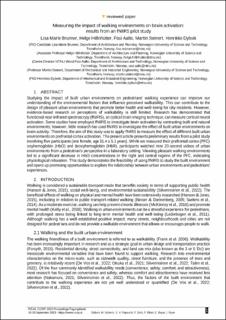| dc.contributor.author | Brunner, Lisa Marie | |
| dc.contributor.author | Hillnhütter, Helge | |
| dc.contributor.author | Aalto, Pasi Olav | |
| dc.contributor.author | Steinert, Martin | |
| dc.contributor.author | Dybvik, Henrikke | |
| dc.date.accessioned | 2023-10-18T14:28:53Z | |
| dc.date.available | 2023-10-18T14:28:53Z | |
| dc.date.created | 2023-10-08T20:37:45Z | |
| dc.date.issued | 2023 | |
| dc.identifier.isbn | 978-3-9504945-2-5 | |
| dc.identifier.uri | https://hdl.handle.net/11250/3097335 | |
| dc.description.abstract | Studying the impact of built urban environments on pedestrians' walking experience can improve our understanding of the environmental factors that influence perceived walkability. This can contribute to the design of pleasant urban environments that promote better health and well-being for city residents. However, evidence-based research on perceptions of walkability is still limited. Research has demonstrated that functional near-infrared spectroscopy (fNIRS), an optical brain imaging technique, can measure cortical neural activation. Some studies have employed fNIRS to investigate brain activation by contrasting built and natural environments; however, little research has used fNIRS to investigate the effect of built urban environments on brain activity. Therefore, the aim of this study was to apply fNIRS to measure the effect of different built urban environments on prefrontal cortex activation. The present article presents preliminary results from a pilot study involving five participants (one female, age 31.4 ± 5.1 years). While we measured their prefrontal cortex (PFC) oxyhemoglobin (HbO) and deoxyhemoglobin (HbR), participants watched nine 20-second videos of urban environments from a pedestrian's perspective in a laboratory setting. Viewing pleasant walking environments led to a significant decrease in HbO concentrations in the right and central regions of the PFC, indicating physiological relaxation. This study demonstrates the feasibility of using fNIRS to study the built environment and opens up promising opportunities to explore the relationship between urban environments and pedestrians' experiences. | en_US |
| dc.language.iso | eng | en_US |
| dc.publisher | REAL CORP | en_US |
| dc.relation.ispartof | Nature-based Solutions for Sustainable Resilient Smart Green and Blue Cities, Proceedings of REAL CORP 2023 | |
| dc.rights | Navngivelse 4.0 Internasjonal | * |
| dc.rights.uri | http://creativecommons.org/licenses/by/4.0/deed.no | * |
| dc.subject | Psykisk velvære | en_US |
| dc.subject | Psychological well-being | en_US |
| dc.subject | Fotgjengere | en_US |
| dc.subject | Pedestrian | en_US |
| dc.subject | Helse | en_US |
| dc.subject | Health | en_US |
| dc.subject | Built environment | en_US |
| dc.subject | Built environment | en_US |
| dc.subject | FNIRS | en_US |
| dc.subject | FNIRS | en_US |
| dc.title | Measuring the Impact of Walking Environments on Brain Activation: Results from an fNIRS Pilot Study | en_US |
| dc.title.alternative | Measuring the Impact of Walking Environments on Brain Activation: Results from an fNIRS Pilot Study | en_US |
| dc.type | Chapter | en_US |
| dc.description.version | acceptedVersion | en_US |
| dc.subject.nsi | VDP::Arkitektur og design: 140 | en_US |
| dc.subject.nsi | VDP::Architecture and design: 140 | en_US |
| dc.subject.nsi | VDP::Arkitektur og design: 140 | en_US |
| dc.subject.nsi | VDP::Architecture and design: 140 | en_US |
| dc.source.pagenumber | 513-524 | en_US |
| dc.identifier.cristin | 2182685 | |
| cristin.ispublished | true | |
| cristin.fulltext | original | |
| cristin.fulltext | original | |

